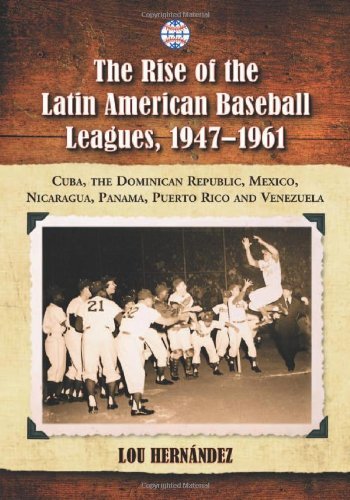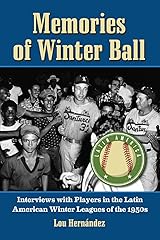
INTERVIEW WITH BASEBALL WRITER LOU HERNANDEZ
by Ismael Nunez
Lou Hernandez is a member of the Society of American Baseball Research and a life-long baseball fan. He’s written two Baseball Books on Latin America:
Memories of Winter Ball: Interviews with Players in the Latin American Winter Leagues of the 1950s .
The Rise of the Latin American Baseball Leagues, 1947-1961: Cuba, the Dominican Republic, Mexico, Nicaragua, Panama, Puerto Rico, and Venezuela

In contacting him he was honored to do an interview. He also stated proudly his reasons for writing these two books. If one wants to learn a chapter about Latin America, its relationship with Major League Baseball, or the Winter Leagues, here are these two books. During the interview, which was conducted via email, he described in full detail on these books and what he would like people to learn.
1-What got you interested in writing these two books?
I have always loved baseball and have always been aware of my Hispanic heritage.
(I was born in Cuba .) Writing my books were a great way to combine these deep
Personal interests.
I view my books as serving to promote baseball and to promote the rich Latin
American history within the game and my two books specifically deal with the nostalgic “Golden Era” of baseball from the 1950s.
2.-Did you do a lot of traveling to do the research for these two books?
In my first book, although I extensively covered the Latin American baseball leagues
Of the ’40s and ’50s, I did not travel to any of the countries. The book is a narrative
History and I researched my work through newspapers and periodicals of the time, as
Well as published books. I did travel to Puerto Rico and interviewed several players
For my second book.
3-Now these countries all have a relationship with Major League Baseball?
There were eight Latin American countries that had baseball leagues with ties to
Organized baseball during the decade of the 1950: They were: Colombia, Cuba, Dominican Republic, Mexico, Nicaragua, Panama, Puerto Rico and Venezuela. I covered seven countries for my first book. North American minor and major league players came over to play in all of these countries.
4-Many Negro League Players got their start playing in Latin America. Most are now aware, true
Many Latin American players played in the Negro leagues, and since the Negro leagues
Seasons were in the summer, the Latin American players could play in the United
States and then would return to leagues over the winter. Many great Negro leagues
Players such as Josh Gibson and Sam Jethroe and Monte Irvin, played in the Latin American Baseball Leagues just to name a few.
5-Do these leagues have the same as they do in MLB: Commissioner, President?
-. The Latin American Leagues all had their own league president and conducted
Business independently of each another, and Four of these leagues’ countries — Cuba,
Panama , Puerto Rico and Venezuela – formed the Caribbean Professional Baseball
Federation, which introduced the first Caribbean Series in the year 1949, The Latin American leagues were part of organized baseball, so they were governed
By the National Association of Baseball Leagues, who is the executive governing?
Body of all minor league baseball leagues in the United States.
6- The Minor Leagues and the Winter Leagues are they similar? And how does one player from the Major Leagues play in Winter Ball
The Winter Leagues of the day were like the minor leagues. Just as the major league
clubs had affiliate minor league teams in the U.S. , so too did major league clubs
establish what was referred to as “working relationships” with clubs in all of the Latin
American leagues, for which the major league teams would send their top prospects to these Latin American clubs over the winter for the players to gain more experience playing against top competition. Yet today it’s different now. Very few North American players play in the Caribbean over the winter. American League and National League clubs are solely interested in the foreign talent, today. The individual organizations have set up their own baseball academies in several Latin American baseball countries, trying to develop the native-born talent exclusively for their big league clubs.
7-So did anyone tell you a bad experience they’ve had?
My second book, which is an oral history, delves much more into the individual
Experiences of what it was like to play in the Latin American baseball leagues of the
Era. Most of the players relayed what enjoyable experiences they had, although there
Are always a few incidents, due to circumstances that turn out not so pleasant – but very few?
8-There were no Latin Americans named to the All Century Team why?
There were so many great players during the last century. I think because it took many
Decades for Hispanic players to reach the major leagues, that hurt as far as gaining
Legendary recognition! Now, with such a Latin American influence in the game, you
Can bet the all 21st Century team will have a few Hispanic players on it. Although
Most of us will not be around to see the selections!
9-Currently there is a movement to retire Roberto Clemente’s Number 21.
Clemente is considered the greatest all-around Hispanic player to play in the major
Leagues and he was a greater human being than he was a ballplayer. I would not be
Opposed to the retirement of his number by MLB, but I do not think it will happen.
Retiring his number will lessen the impact of retiring Jackie Robinson’s number, and
MLB does not want to do that.
10-You feel proud of what you’ve written in these two books.
I think my two books capture, from historical and personal perspectives, what
The “Golden Age” of baseball was like in the Tropics during the 1950s. That is what
I set out to do. I think all baseball fans, even casual fans, can learn a great deal (as I
Did) from the books and be entertained at the same time.
